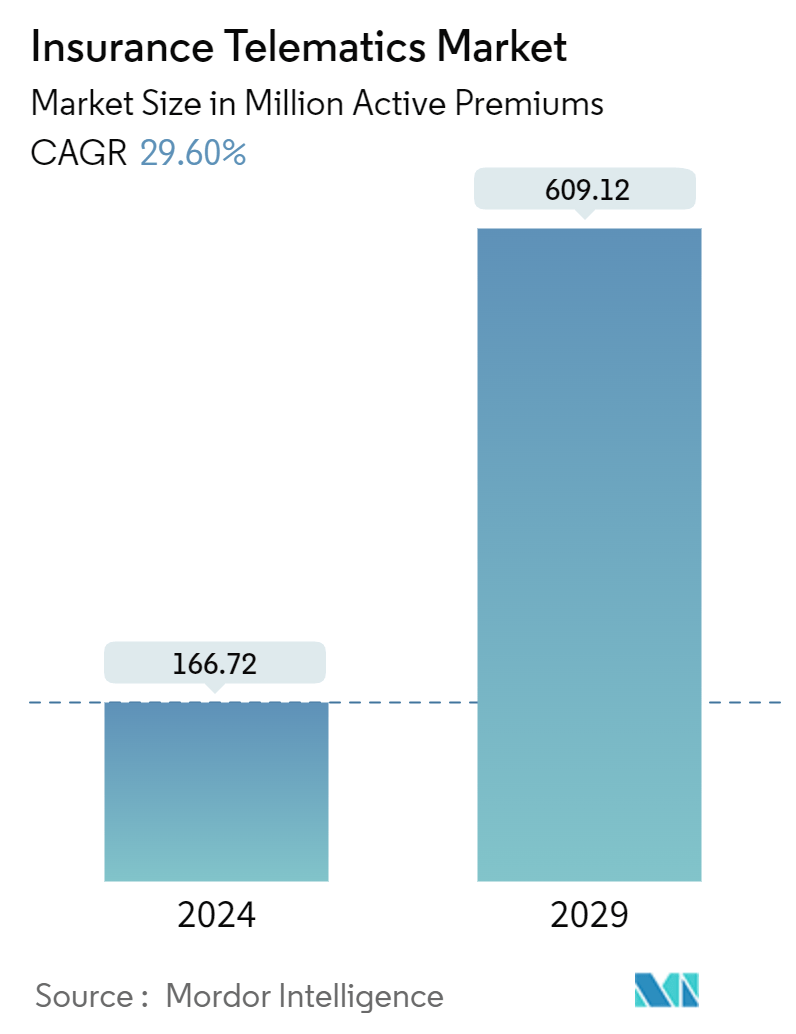Market Size of Insurance Telematics Industry

| Study Period | 2022 - 2029 |
| Base Year For Estimation | 2023 |
| CAGR (2024 - 2029) | 29.60 % |
| Fastest Growing Market | Asia Pacific |
| Largest Market | North America |
| Market Concentration | Low |
Major Players
*Disclaimer: Major Players sorted in no particular order |
Insurance Telematics Market Analysis
The Insurance Telematics Market size is estimated at 166.72 Million active premiums in 2024, and is expected to reach 609.12 Million active premiums by 2029, growing at a CAGR of 29.60% during the forecast period (2024-2029).
Insurance telematics is most frequently used to track how people drive. It involves technology, such as GPS and sensors, to monitor and collect data on an individual's driving behavior. Insurance organizations use this data to assess risk and set personalized premiums accurately. Telematics devices installed in a vehicle help to track various parameters, such as speed, distance, and driving habits, which allows insurers to reward safe driving or adjust premiums based on actual usage patterns.
- Rising congestion and road traffic have made people's safety a top priority. Improving advanced vehicle features is a significant factor aiding the growth of the demand for vehicle insurance telematics. .
- Similarly, in the European Union, around 20,400 people were killed in road crashes in 2023. As per the European Commission report, the number declined by a small 1% compared to 2022. More than 2,000 cyclists were killed in 2022 in the EU. The deaths of cyclists are a severe concern in the country. In 2022, car drivers and passengers accounted for 45% of all fatalities, while pedestrians registered 18%, two-wheelers, motorbikes, and mopeds users accounted for 19%, and cyclists 10% of all fatalities.
- According to the Ministry of Road (India), There were 4,61,312 road accidents across the country. According to WHO, more than 90% of road traffic deaths occur in low- and middle-income regions. Road traffic injury death rates are highest in the African area and lowest in the European area. Even within high-income countries, individuals from lower socioeconomic backgrounds are more likely to be involved in road traffic crashes. Such a rise in road accidents would drive the demand for the market.
- Such increases in road accidents may create demand for insurance telematics in the region. Telematics devices provide enhanced security by tracking driver activity during accidents and facilitating emergency response and retrieval of the stolen vehicle. It also delivers real-time responses to drivers' driving behaviors that assist drivers in modifying their driving behavior and adopting safer practices.
- A significant barrier to adopting telematics standards is the technical complexity and diversity of telematics systems and devices. Many types of telematics hardware, software, and protocols exist, such as onboard diagnostics (OBD), global positioning systems (GPS), cellular, satellite, Bluetooth, and Wi-Fi. These technologies have different capabilities, limitations, and compatibility issues, making it difficult to integrate and communicate.
- Economic conditions such as GDP growth, unemployment rates, and disposable income levels influence consumer spending behavior, including insurance purchases. During periods of economic development, consumers may be more willing to invest in optional services like insurance telematics. Conversely, during economic downturns, consumers may prioritize essential expenses, potentially slowing the growth of the insurance telematics market.
Insurance Telematics Industry Segmentation
The market for insurance telematics was analyzed considering the total number of active premiums filed by the various insurance providers operating worldwide.
The insurance telematics market is segmented by usage type (pay-as-you-drive, pay-how-drive, manage-how-you-drive) and geography (North America, Europe, Asia-Pacific, Rest of the World). The market sizes and forecasts are provided in terms of the number of active premiums for all the above segments.
| By Usage Type | |
| Pay-as-you-drive | |
| Pay-how-you-drive | |
| Manage-how-you-drive |
| By Geography*** | |
| North America | |
| Europe | |
| Asia | |
| Australia and New Zealand | |
| Latin America | |
| Middle East and Africa |
Insurance Telematics Market Size Summary
The insurance telematics market is experiencing significant growth, driven by the increasing adoption of technology to monitor and analyze driving behavior. This market leverages GPS and sensor technologies to collect data on various driving parameters, enabling insurers to assess risk more accurately and offer personalized premiums. The rising concern over road safety, coupled with the demand for advanced vehicle features, is propelling the market forward. The implementation of pay-how-you-drive insurance models, which adjust premiums based on individual driving habits, is gaining traction, offering financial incentives for safer driving. This trend is further supported by the growing popularity of electric vehicles and government regulations promoting their use, which are expected to enhance the integration of telematics in the insurance sector.
Despite the promising growth prospects, the market faces challenges such as the technical complexity and diversity of telematics systems, which can hinder widespread adoption. Economic factors also play a crucial role, as consumer willingness to invest in telematics-based insurance can fluctuate with economic conditions. The market is characterized by a high degree of fragmentation, with numerous global players and SMEs competing for market share. Strategic partnerships and acquisitions are common as companies seek to enhance their product offerings and gain a competitive edge. Innovations in mobile apps and advanced driver assistance systems are also contributing to market expansion, particularly in regions like North America. Overall, the insurance telematics market is poised for substantial growth, driven by technological advancements and evolving consumer preferences.
Insurance Telematics Market Size - Table of Contents
-
1. MARKET INSIGHTS
-
1.1 Market Overview
-
1.2 Industry Attractiveness - Porter's Five Forces Analysis
-
1.2.1 Bargaining Power of Suppliers
-
1.2.2 Bargaining Power of Buyers
-
1.2.3 Threat of New Entrants
-
1.2.4 Threat of Substitute Products
-
1.2.5 Degree of Competition
-
-
1.3 Assessment of Macroeconomics Factors on the Market Covering COVID-19 Impact
-
1.4 Industry Value Chain Analysis
-
-
2. MARKET SEGMENTATION
-
2.1 By Usage Type
-
2.1.1 Pay-as-you-drive
-
2.1.2 Pay-how-you-drive
-
2.1.3 Manage-how-you-drive
-
-
2.2 By Geography***
-
2.2.1 North America
-
2.2.2 Europe
-
2.2.3 Asia
-
2.2.4 Australia and New Zealand
-
2.2.5 Latin America
-
2.2.6 Middle East and Africa
-
-
Insurance Telematics Market Size FAQs
How big is the Insurance Telematics Market?
The Insurance Telematics Market size is expected to reach 166.72 million active premiums in 2024 and grow at a CAGR of 29.60% to reach 609.12 million active premiums by 2029.
What is the current Insurance Telematics Market size?
In 2024, the Insurance Telematics Market size is expected to reach 166.72 million active premiums.

